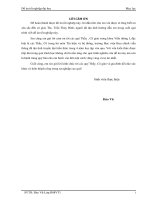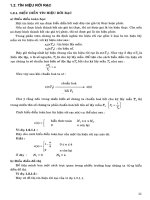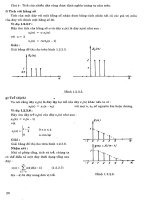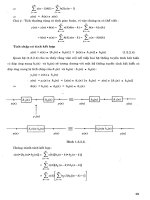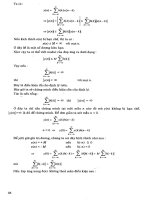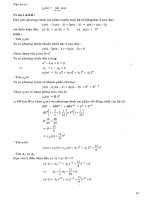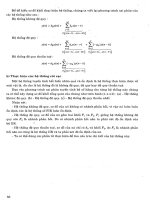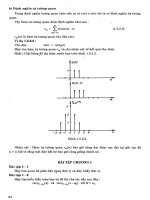Finaldsp 2014 tt XỬ LÝ TÍN HIỆU SỐ
Bạn đang xem bản rút gọn của tài liệu. Xem và tải ngay bản đầy đủ của tài liệu tại đây (229.41 KB, 3 trang )
Digital Signal Processing
by Assoc. Prof. Dr. Thuong Le-Tien
FINAL EXAMINATION
Digital Signal Processing
Date of Exam: December 25th, 2014 - Class CT11TIEN
Time allowed: 150 Minutes
Signature of the lecturer
Signature of the EEE Dept
INSTRUCTION:
1. One page A4 of personal notes is allowed in the exam!
2. Answer 5 from 6 recommended questions
PART 1: Answer three following questions (60 marks)
Question 1: (20 marks)
Consider the cascade of LTI discrete-time systems shown in Figure
0.5 ,
1,
j
The first system is described by the equation H 1 (e )
0.5 ,
0,
And the second system is described by the equation y(n) = w(n) - w(n-1). The input to
this system is x(n) = cos(0.6n) + 3(n-5) + 2.
a. What the frequency components of the x(n)?
b. Sketch the magnitude response H1(ejw) then conclude about the kind of the filter of
the first system (e.g. LPF, HPF, BPF or BSF) then based on the frequency
components of the x(n), discuss about the output signal w(n) of the first system?
c. Using the properties of LTI systems, determine the output y(n)?
Question 2: (20 marks)
The given signal x(n) = 4cos(n/2) + cos(n),
a. Compute the 8-point DFT of the length-8 signal, x1(n), in which these samples are
the first 8 samples of the given signal x(n) (e.g. values of n from 0 to 7)
b. Repeat the question 2.a. for the first 10 samples of the signal x(n) using the
wrapped signal approach.
c. Check the result in question 2.a by using the 8-point FFT.
Question 3: (20 marks)
Given the signal H ( Z )
1 0.5Z 1
(1 Z 1 )(1 2Z 2 )
a. Find the available inverse-Z-Transform, discuss about the ROCs, Stability and
Causality of the solutions
b. Realize the system using the direct form 1 and canonical form for the causal case.
Final Examination, December 25th 2014
1
Digital Signal Processing
by Assoc. Prof. Dr. Thuong Le-Tien
PART 2: Select two from three following questions
Question 4: (20 marks) A stable system shown in the figure has a1=1.5, a2=1 and b2=2.
a.
b.
c.
d.
Write the Input/output difference equation of the system.
Specify the Region of Convergence ROC.
Find the impulse response of the system.
Specify the response of system to the input x(n)={0,-1,-2,0,3} using the
convolution table
Question 5: (20 marks) The system T in the given figure is known to be time
invariant. When the input to the system are x1(n), x2(n), and x3(n), the responses of the
system are y1[n], y2[n], and y3[n], as shown.
a. Determine whether the system T could be linear.
b. If the input x[n] to the system is [n], what is the system response y[n]?
c. What are all possible inputs x[n] for which the response of the system T can be
determined from the given information alone?
Hint: Find the relationship between x1(n), x2(n), and x3(n) then apply the LTI property
Question 6: (20 marks)
An LTI system has impulse response h(n) = u(n)
a. Determine y1(n), the response of the system to the input x1 (n) e j ( / 2) n ,
b. Use the result of Question 6.a to help to determine y2(n), the response of the system
to the input x2(n) = cos(n/2)
c. Determine y3(n), the response of the system to the input x3 (n) e
j ( / 2 ) n
u ( n)
Hint: Transform the h(n) into the Fourier domain then apply y(n)=x(n)H(j)
End.
Good lucks!
Final Examination, December 25th 2014
2
Digital Signal Processing
by Assoc. Prof. Dr. Thuong Le-Tien
SOLUTIONS
Question 1:
First x(n) goes through a LPF with cut-off frequency 0.5. Since the cosine has a
frequency of 0.6, it will be filter out. The delayed impulse will be filtered to a delayed
sinc and the constant will remain unchanged. We thus get:
w(n) 3
sin(0.5 (n 5))
2
(n 5)
y ( n) 3
sin(0.5 ( n 5))
sin(0.5 (n 6))
3
(n 5)
( n 6)
Question 2:
a. X={5,-1,-3,-1,5,-1,-3,-1} then X={0,0,16,0,8,0,16,0}
b. Wrapped signal: xw={10,-2,-3,-1,5,-1,-3,-1}
c. FFT applied to the x(n) will be exactly the same as the result in 2.a.
Question 3:
A
B
C
Solve for A,B,C then work out for
1
(1 Z ) (1 j 2 Z 1 ) (! j 2 Z 1 )
the ROC, stability and Causality.
b. Realize the direct form 1 and canonical form for the causal case.
a. Rewrite: H ( Z )
Question 4:
a. I/O equation : y(n) = b2x(n-2) + a1y(n-1) + a2y(n-2) where a1=1.5, a2=1 and b2=2.
2 Z 2
2 Z 2
b. H ( z )
1 1.5Z 1 Z 2 (1 2 Z 1 )(1 0.5Z 1 )
System has two poles: 2 and -0.5 so 0.5
a. Causal signal x(n)={0,-1,-2,0,3}; h(n)={0,0,2,3,6.5,…..}(assumed for only first five
terms for the IIR filter)
b. then apply the convolution table, obtained y(n)={0,0,0,-2,1,-0.5,19,9,19.5}
Question 5:
a. Notice that x1(n) = x2(n)+ x3(n+4) but y1(n) is not equal y2(n)+ y3(n+4) then the
system is not linear
b. Note that x3(n+4)=(n) therefore h(n)= 3(n+6)+2(n+5)
c. Since the system is known TI but not Linear, so we can not use choices such as:
(n)= x1(n) - x2(n) and (n)= 1/2 x2(n+1) to determine the impulse response. With
the given information, we can only use shifted input.
Question 6:
a. Write: H ( j )
b. Write: x 2 (n)
1
then y1(n)=x1(n).H(j)
1 e j
1 nj / 2)
e
e nj / 2 then y2(n)=x2(n).H(j)
2
c. Similar for then y3(n)=x3(n).H(j) with n > or = 0
Final Examination, December 25th 2014
3

